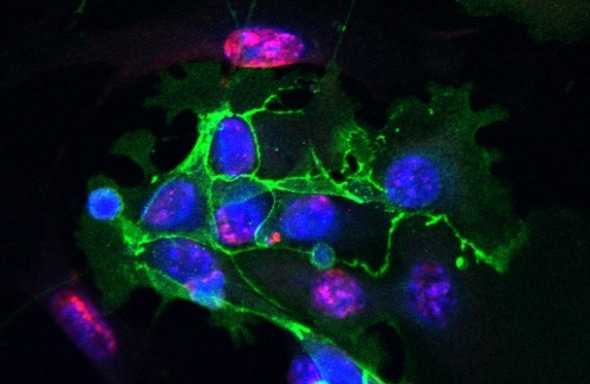Aug 4 2017
Pulmonary fibrosis can possibly be attributed to a kind of cellular aging process, which is called senescence. This has been shown by researchers from the Helmholtz Zentrum München, partner in the German Center for Lung Research (DZL). As they report in the ‘European Respiratory Journal’, they have already successfully counteracted this mechanism in the cell culture with the help of drugs.

Sample of lung fibrosis: Green cells show markers of the lung epithelium, red cells are undergoing senescence. The nuclei are stained in blue. Source: Helmholtz Zentrum München
Pulmonary fibrosis causes the patient’s lung tissue to scar, resulting in progressive pulmonary function deterioration. In particular, the surface of the alveoli (called the alveolar epithelium) is often affected. If the disease’s origin is unknown, the condition is called idiopathic pulmonary fibrosis, or IPF for short. “The treatment options for IPF have been few and far between,” explains Dr. Mareike Lehmann, scientist in the Lung Repair and Regeneration Research Unit (LRR) at the Helmholtz Zentrum München. “We are therefore attempting to understand how the disease comes about so that we can facilitate targeted treatment.”
In the current work, Lehmann and additional researchers, headed by department head Prof. Dr. Dr. Melanie Königshoff, have now succeeded in solving another piece of the puzzle. “In both the experimental model and in the lungs of IPF patients, we were able to show that some cells in the alveolar epithelium have markers for senescence,” explains study leader Königshoff. “Because the occurrence of IPF increases with age, this was already suspected. We have now succeeded in proving this hypothesis.”
Senescence promotes pulmonary fibrosis in two ways
Senescence impairs lung function in two ways: It prevents lung cells from dividing when they need to be replaced. And senescent cells secrete mediators that further promote fibrosis. Since this effect also plays a role in cancer, the scientists were able to access an already existing group of medicines, the so-called senolytic drugs that selectively kill off senescent cells.
Pulmonary fibrosis stopped in the cell culture
In order to test possible treatment strategies, the scientists placed the affected cells into a three-dimensional cell culture and examined the drugs’s effect ex vivo, so to speak. Mareike Lehmann:
We observed that this caused a decline in the quantity of secreted mediators and additionally a reduction in the mass of connective tissue proteins, which are greatly increased in the disease.
Altogether, the study shows that senescence in the cells of the alveolar epithelium can contribute to the development and worsening of IPF. This finding is new and constitutes a possible starting point for the development of new treatments.